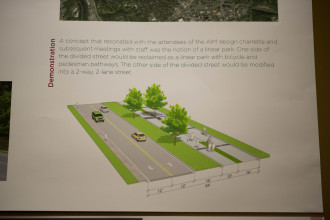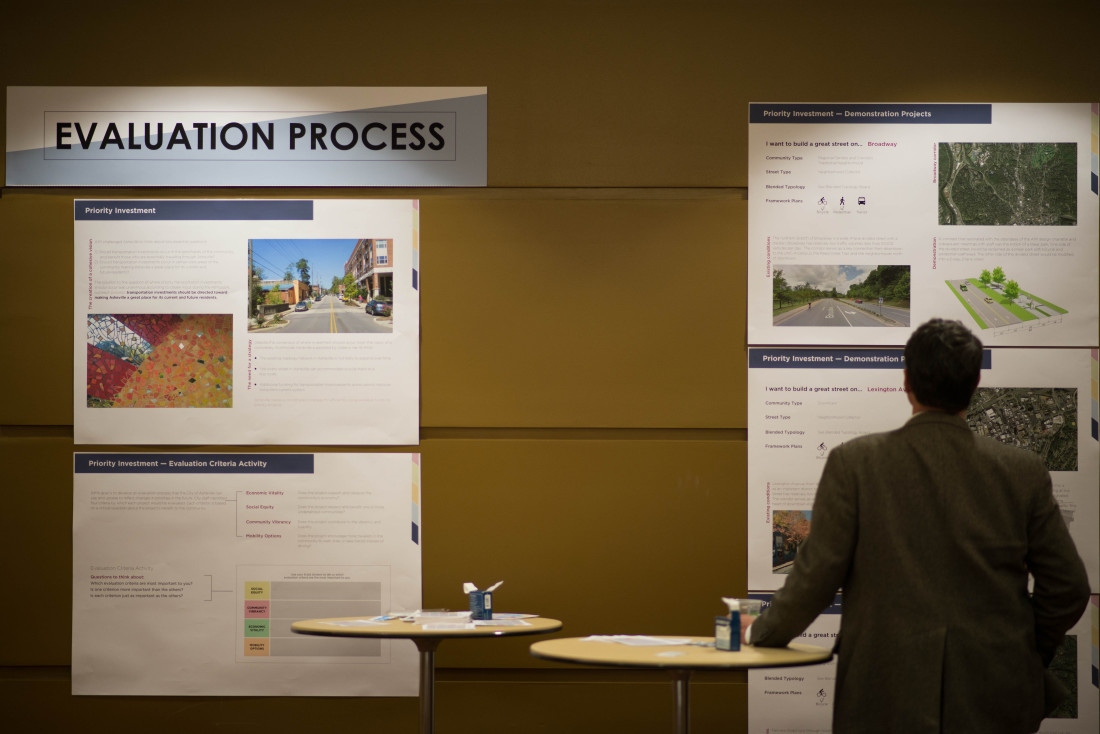The future of getting around the city via foot, bicycle, private vehicle or mass transit took another step forward in the form of the final-draft presentation of Asheville in Motion (AIM), a comprehensive study and information-gathering endeavor that the city can use to shape its transportation priorities over the horizon.
“This wasn’t about creating yet another plan. It was about developing a strategy,” said Stephen Stansbery of Raleigh-based design firm Kimley-Horn, which presented data to the public Dec. 7 at the U.S. Cellular Center. “That begins with understanding what’s going on in our community in terms of demographic and economic growth, and changing conditions with respect to funding. The one constant we do know throughout the process is, Asheville is growing, and we need to be prepared for that.”

Asheville’s population was 83,000 in 2010, and is projected to rise to 120,000 by 2040. The city currently has 211 miles of sidewalks, 500 miles of park paths, driveway paths, crosswalks and greenways, and 15 miles of dedicated bike paths, with 17 ART bus routes. Ten percent of households have no access to a vehicle.
Beginning in May 2014, the City of Asheville began working on a plan to address and prioritize the city’s transportation needs in the coming population boom. The AIM plan is a community-driven effort to meet travel needs and create choices among the city’s mobility options. The City’s expressed goal is to create an effective and progressive plan that encourages health-oriented and sustainable transportation, reduces barriers to the access of transportation, and connects residents and visitors with the places they want and need to go with improved safety, efficiency and accessibility.
The public was encouraged to provide input on these issues in spring 2015 during a multi-day charrette. With the final draft being presented this week, the next steps will be (1) a public hearing in spring 2016, (2) a presentation of the proposed plan to the Multimodal Transportation Commission and to City Council’s Planning and Economic Development Committee, and (3) consideration by City Council for adoption or other action.

City staff identified four criteria to be looked at in regards to future transportation projects:
- Economic vitality — does the project support and catalyze the community’s economy?
- Social equity — does the project respect and benefit one or more under-served communities?
- Community vibrance — does the project contribute to the vibrancy and livability of the community?
- Mobility options — does the project encourage more travelers in the community to walk, bike or use public transit instead of driving?
The city was clear from the start that as many people from all walks of life should have input into the project.
“The public participation has been rewarding. It’s great when the public comes and tells you what their needs are,” said Mariate Echeverry, transportation planning manager for the city. “We have a very engaged community; it’s great that they take their time to come and tell us what they need.”



Before you comment
The comments section is here to provide a platform for civil dialogue on the issues we face together as a local community. Xpress is committed to offering this platform for all voices, but when the tone of the discussion gets nasty or strays off topic, we believe many people choose not to participate. Xpress editors are determined to moderate comments to ensure a constructive interchange is maintained. All comments judged not to be in keeping with the spirit of civil discourse will be removed and repeat violators will be banned. See here for our terms of service. Thank you for being part of this effort to promote respectful discussion.